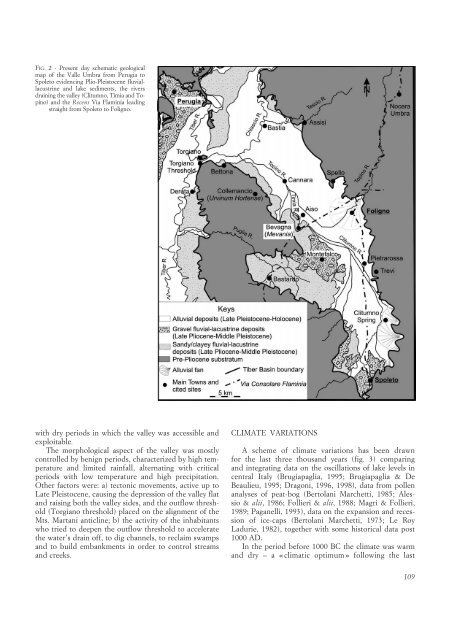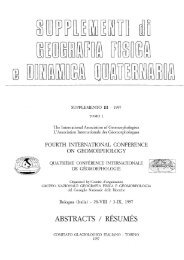Full Text (PDF)
Full Text (PDF)
Full Text (PDF)
Create successful ePaper yourself
Turn your PDF publications into a flip-book with our unique Google optimized e-Paper software.
FIG. 2 - Present day schematic geological<br />
map of the Valle Umbra from Perugia to<br />
Spoleto evidencing Plio-Pleistocene fluviallacustrine<br />
and lake sediments, the rivers<br />
draining the valley (Clitumno, Timia and Topino)<br />
and the Recens Via Flaminia leading<br />
straight from Spoleto to Foligno.<br />
with dry periods in which the valley was accessible and<br />
exploitable.<br />
The morphological aspect of the valley was mostly<br />
controlled by benign periods, characterized by high temperature<br />
and limited rainfall, alternating with critical<br />
periods with low temperature and high precipitation.<br />
Other factors were: a) tectonic movements, active up to<br />
Late Pleistocene, causing the depression of the valley flat<br />
and raising both the valley sides, and the outflow threshold<br />
(Torgiano threshold) placed on the alignment of the<br />
Mts. Martani anticline; b) the activity of the inhabitants<br />
who tried to deepen the outflow threshold to accelerate<br />
the water’s drain off, to dig channels, to reclaim swamps<br />
and to build embankments in order to control streams<br />
and creeks.<br />
CLIMATE VARIATIONS<br />
A scheme of climate variations has been drawn<br />
for the last three thousand years (fig. 3) comparing<br />
and integrating data on the oscillations of lake levels in<br />
central Italy (Brugiapaglia, 1995; Brugiapaglia & De<br />
Beaulieu, 1995; Dragoni, 1996, 1998), data from pollen<br />
analyses of peat-bog (Bertolani Marchetti, 1985; Alessio<br />
& alii, 1986; Follieri & alii, 1988; Magri & Follieri,<br />
1989; Paganelli, 1993), data on the expansion and recession<br />
of ice-caps (Bertolani Marchetti, 1973; Le Roy<br />
Ladurie, 1982), together with some historical data post<br />
1000 AD.<br />
In the period before 1000 BC the climate was warm<br />
and dry – a «climatic optimum» following the last<br />
109















